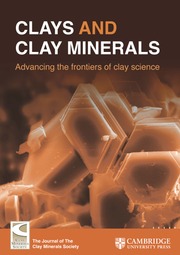Crossref Citations
This article has been cited by the following publications. This list is generated based on data provided by
Crossref.
LÉVEILLÉ, R. J.
LONGSTAFFE, F. J.
and
FYFE, W. S.
2007.
An isotopic and geochemical study of carbonate‐clay mineralization in basaltic caves: abiotic versus microbial processes.
Geobiology,
Vol. 5,
Issue. 3,
p.
235.
BONTOGNALI, TOMASO R. R.
VASCONCELOS, CRISÓGONO
WARTHMANN, ROLF J.
BERNASCONI, STEFANO M.
DUPRAZ, CHRISTOPHE
STROHMENGER, CHRISTIAN J.
and
McKENZIE, JUDITH A.
2010.
Dolomite formation within microbial mats in the coastal sabkha of Abu Dhabi (United Arab Emirates).
Sedimentology,
Vol. 57,
Issue. 3,
p.
824.
Léveillé, Richard J.
and
Datta, Saugata
2010.
Lava tubes and basaltic caves as astrobiological targets on Earth and Mars: A review.
Planetary and Space Science,
Vol. 58,
Issue. 4,
p.
592.
Cuevas, Jaime
Leguey, Santiago
and
Ruiz, Ana I.
2011.
Developments in Palygorskite-Sepiolite Research.
Vol. 3,
Issue. ,
p.
219.
Konhauser, Kurt O.
2011.
Encyclopedia of Geobiology.
p.
274.
Doc Richardson, C.
Hinman, Nancy W.
McHenry, Lindsay J.
Michelle Kotler, J.
Knipe, Dawn L.
and
Scott, Jill R.
2012.
Secondary sulfate mineralization and basaltic chemistry of craters of the Moon National Monument, Idaho: Potential martian analog.
Planetary and Space Science,
Vol. 65,
Issue. 1,
p.
93.
Khaokaew, Saengdao
Landrot, Gautier
Chaney, Rufus L.
Pandya, Kaumudi
and
Sparks, Donald L.
2012.
Speciation and Release Kinetics of Zinc in Contaminated Paddy Soils.
Environmental Science & Technology,
Vol. 46,
Issue. 7,
p.
3957.
Cheeptham, Naowarat
2013.
Cave Microbiomes: A Novel Resource for Drug Discovery.
Vol. 1,
Issue. ,
p.
1.
Léveillé, Richard J.
Bridges, John
Wiens, Roger C.
Mangold, Nicolas
Cousin, Agnes
Lanza, Nina
Forni, Olivier
Ollila, Ann
Grotzinger, John
Clegg, Samuel
Siebach, Kirsten
Berger, Gilles
Clark, Ben
Fabre, Cécile
Anderson, Ryan
Gasnault, Olivier
Blaney, Diana
Deflores, Lauren
Leshin, Laurie
Maurice, Sylvestre
and
Newsom, Horton
2014.
Chemistry of fracture‐filling raised ridges in Yellowknife Bay, Gale Crater: Window into past aqueous activity and habitability on Mars.
Journal of Geophysical Research: Planets,
Vol. 119,
Issue. 11,
p.
2398.
Bontognali, Tomaso R.R.
Martinez-Ruiz, Francisca
McKenzie, Judith A.
Bahniuk, Anelize
Anjos, Sylvia
and
Vasconcelos, Crisogono
2014.
Smectite synthesis at low temperature and neutral pH in the presence of succinic acid.
Applied Clay Science,
Vol. 101,
Issue. ,
p.
553.
Tosca, N. J .
and
Masterson, A. L.
2014.
Chemical controls on incipient Mg-silicate crystallization at 25°C: Implications for early and late diagenesis.
Clay Minerals,
Vol. 49,
Issue. 2,
p.
165.
Zeyen, Nina
Benzerara, Karim
Li, Jinhua
Groleau, Alexis
Balan, Etienne
Robert, Jean-Louis
Estève, Imène
Tavera, Rosaluz
Moreira, David
and
López-García, Purificación
2015.
Formation of low-T hydrated silicates in modern microbialites from Mexico and implications for microbial fossilization.
Frontiers in Earth Science,
Vol. 3,
Issue. ,
Roosz, Cédric
Grangeon, Sylvain
Blanc, Philippe
Montouillout, Valérie
Lothenbach, Barbara
Henocq, Pierre
Giffaut, Eric
Vieillard, Philippe
and
Gaboreau, Stéphane
2015.
Crystal structure of magnesium silicate hydrates (M-S-H): The relation with 2:1 Mg–Si phyllosilicates.
Cement and Concrete Research,
Vol. 73,
Issue. ,
p.
228.
Cámara, Beatríz
Souza-Egipsy, Virginia
Ascaso, Carmen
Artieda, Octavio
De Los Ríos, Asunción
and
Wierzchos, Jacek
2016.
Biosignatures and microbial fossils in endolithic microbial communities colonizing Ca-sulfate crusts in the Atacama Desert.
Chemical Geology,
Vol. 443,
Issue. ,
p.
22.
Perri, Edoardo
Tucker, Maurice E.
Słowakiewicz, Mirosław
Whitaker, Fiona
Bowen, Leon
Perrotta, Ida D.
and
Della Porta, Giovanna
2018.
Carbonate and silicate biomineralization in a hypersaline microbial mat (Mesaieed sabkha, Qatar): Roles of bacteria, extracellular polymeric substances and viruses.
Sedimentology,
Vol. 65,
Issue. 4,
p.
1213.
Tosca, Nicholas J.
and
Wright, V. Paul
2018.
Diagenetic pathways linked to labile Mg-clays in lacustrine carbonate reservoirs: a model for the origin of secondary porosity in the Cretaceous pre-salt Barra Velha Formation, offshore Brazil.
Geological Society, London, Special Publications,
Vol. 435,
Issue. 1,
p.
33.
Gérard, Emmanuelle
De Goeyse, Siham
Hugoni, Mylène
Agogué, Hélène
Richard, Laurent
Milesi, Vincent
Guyot, François
Lecourt, Léna
Borensztajn, Stephan
Joseph, Marie-Béatrice
Leclerc, Thomas
Sarazin, Gérard
Jézéquel, Didier
Leboulanger, Christophe
and
Ader, Magali
2018.
Key Role of Alphaproteobacteria and Cyanobacteria in the Formation of Stromatolites of Lake Dziani Dzaha (Mayotte, Western Indian Ocean).
Frontiers in Microbiology,
Vol. 9,
Issue. ,
Pace, A.
Bourillot, R.
Bouton, A.
Vennin, E.
Braissant, O.
Dupraz, C.
Duteil, T.
Bundeleva, I.
Patrier, P.
Galaup, S.
Yokoyama, Y.
Franceschi, M.
Virgone, A.
and
Visscher, P. T.
2018.
Formation of stromatolite lamina at the interface of oxygenic–anoxygenic photosynthesis.
Geobiology,
Vol. 16,
Issue. 4,
p.
378.
Boschi, Chiara
Bedini, Federica
Baneschi, Ilaria
Rielli, Andrea
Baumgartner, Lukas
Perchiazzi, Natale
Ulyanov, Alexey
Zanchetta, Giovanni
and
Dini, Andrea
2019.
Spontaneous Serpentine Carbonation Controlled by Underground Dynamic Microclimate at the Montecastelli Copper Mine, Italy.
Minerals,
Vol. 10,
Issue. 1,
p.
1.
Bentz, Jennifer L.
and
Peterson, Ronald C.
2020.
The Formation of Clay Minerals in the Mudflats of Bolivian Salars.
Clays and Clay Minerals,
Vol. 68,
Issue. 2,
p.
115.

